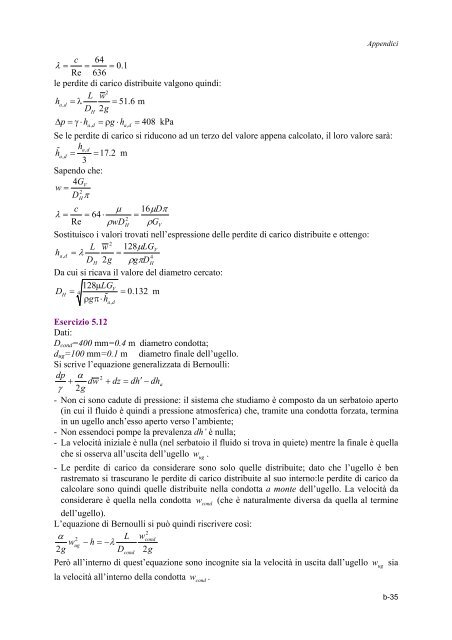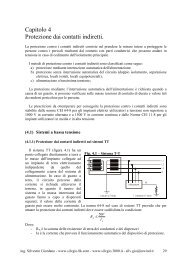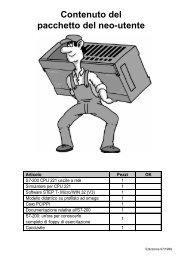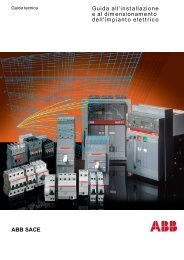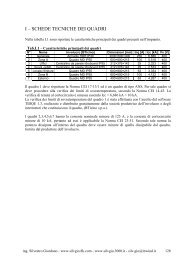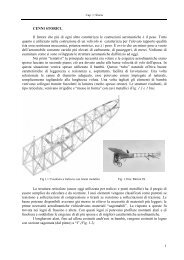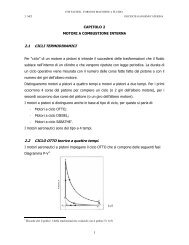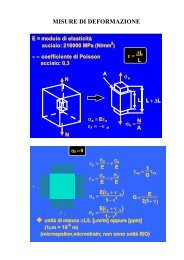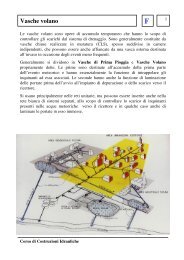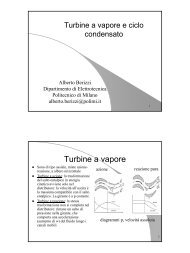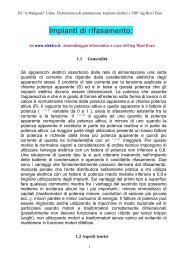- Page 1 and 2:
Appunti ed Esercizi di Fisica Tecni
- Page 3 and 4:
Cap. 1. Nozioni introduttive di Ter
- Page 5 and 6:
Cap. 1. Nozioni introduttive di Ter
- Page 7 and 8:
Cap. 1. Nozioni introduttive di Ter
- Page 9 and 10:
Cap. 1. Nozioni introduttive di Ter
- Page 11 and 12:
Cap. 1. Nozioni introduttive di Ter
- Page 13 and 14:
Cap. 1. Nozioni introduttive di Ter
- Page 15 and 16:
Cap. 1. Nozioni introduttive di Ter
- Page 17 and 18:
Cap. 1. Nozioni introduttive di Ter
- Page 19 and 20:
Cap. 1. Nozioni introduttive di Ter
- Page 21 and 22:
Cap. 1. Nozioni introduttive di Ter
- Page 23 and 24:
Cap. 1. Nozioni introduttive di Ter
- Page 25 and 26:
Cap. 1. Nozioni introduttive di Ter
- Page 27 and 28:
Cap. 1. Nozioni introduttive di Ter
- Page 29 and 30:
Cap. 1. Nozioni introduttive di Ter
- Page 31 and 32:
Cap. 1. Nozioni introduttive di Ter
- Page 33 and 34:
Cap. 1. Nozioni introduttive di Ter
- Page 35 and 36:
Cap. 1. Nozioni introduttive di Ter
- Page 37 and 38:
Cap. 1. Nozioni introduttive di Ter
- Page 39 and 40:
Cap. 2. Cenni sui meccanismi di tra
- Page 41 and 42:
Cap. 2. Cenni sui meccanismi di tra
- Page 43 and 44:
Cap. 2. Cenni sui meccanismi di tra
- Page 45 and 46:
Cap. 2. Cenni sui meccanismi di tra
- Page 47 and 48:
Cap. 2. Cenni sui meccanismi di tra
- Page 49 and 50:
Cap. 2. Cenni sui meccanismi di tra
- Page 51 and 52:
Cap. 2. Cenni sui meccanismi di tra
- Page 53 and 54:
Cap. 2. Cenni sui meccanismi di tra
- Page 55 and 56:
Cap. 2. Cenni sui meccanismi di tra
- Page 57 and 58:
Cap. 2. Cenni sui meccanismi di tra
- Page 59 and 60:
Cap. 2. Cenni sui meccanismi di tra
- Page 61 and 62:
Cap. 2. Cenni sui meccanismi di tra
- Page 63 and 64:
Cap. 2. Cenni sui meccanismi di tra
- Page 65 and 66:
Cap. 2. Cenni sui meccanismi di tra
- Page 67 and 68:
Cap. 2. Cenni sui meccanismi di tra
- Page 69 and 70:
Cap. 2. Cenni sui meccanismi di tra
- Page 71 and 72:
Cap. 2. Cenni sui meccanismi di tra
- Page 73 and 74:
Cap. 2. Termodinamica degli stati I
- Page 75 and 76:
Cap. 2. Termodinamica degli stati m
- Page 77 and 78:
Cap. 2. Termodinamica degli stati u
- Page 79 and 80:
Cap. 2. Termodinamica degli stati m
- Page 81 and 82:
Cap. 2. Termodinamica degli stati l
- Page 83 and 84:
Cap. 2. Termodinamica degli stati
- Page 85 and 86:
Cap. 2. Termodinamica degli stati E
- Page 87 and 88:
Cap. 2. Termodinamica degli stati T
- Page 89 and 90:
Cap. 2. Termodinamica degli stati E
- Page 91 and 92:
Cap. 2. Termodinamica degli stati 1
- Page 93 and 94:
Cap. 2. Termodinamica degli stati p
- Page 95 and 96:
Cap. 2. Termodinamica degli stati E
- Page 97 and 98:
Cap. 2. Termodinamica degli stati
- Page 99 and 100:
Cap. 2. Termodinamica degli stati M
- Page 101 and 102:
Cap. 2. Termodinamica degli stati E
- Page 103 and 104:
Cap. 2. Termodinamica degli stati D
- Page 105 and 106:
Cap. 2. Termodinamica degli stati A
- Page 107 and 108:
Cap. 2. Termodinamica degli stati G
- Page 109 and 110:
Cap. 2. Termodinamica degli stati F
- Page 111 and 112:
Cap. 2. Termodinamica degli stati F
- Page 113 and 114:
Cap. 3. Le equazioni di bilancio di
- Page 115 and 116:
Cap. 3. Le equazioni di bilancio di
- Page 117 and 118:
Cap. 3. Le equazioni di bilancio di
- Page 119 and 120:
Cap. 3. Le equazioni di bilancio di
- Page 121 and 122:
Cap. 3. Le equazioni di bilancio di
- Page 123 and 124:
Cap. 3. Le equazioni di bilancio di
- Page 125 and 126:
Cap. 3. Le equazioni di bilancio di
- Page 127 and 128:
Appunti ed Esercizi di Fisica Tecni
- Page 129 and 130:
Cap. 4. I sistemi aperti a regime
- Page 131 and 132:
Cap. 4. I sistemi aperti a regime c
- Page 133 and 134:
Cap. 4. I sistemi aperti a regime Q
- Page 135 and 136:
Cap. 4. I sistemi aperti a regime (
- Page 137 and 138:
Cap. 4. I sistemi aperti a regime W
- Page 139 and 140:
Cap. 4. I sistemi aperti a regime G
- Page 141 and 142:
Cap. 4. I sistemi aperti a regime E
- Page 143 and 144:
Cap. 4. I sistemi aperti a regime P
- Page 145 and 146:
Cap. 4. I sistemi aperti a regime
- Page 147 and 148:
Cap. 4. I sistemi aperti a regime h
- Page 149 and 150:
Cap. 4. I sistemi aperti a regime d
- Page 151 and 152:
Cap. 4. I sistemi aperti a regime E
- Page 153 and 154:
Cap. 4. I sistemi aperti a regime U
- Page 155 and 156:
Cap. 4. I sistemi aperti a regime
- Page 157 and 158:
Cap. 4. I sistemi aperti a regime k
- Page 159 and 160:
Cap. 4. I sistemi aperti a regime E
- Page 161 and 162:
Cap. 4. I sistemi aperti a regime
- Page 163 and 164:
Cap.5. L’equazione generalizzata
- Page 165 and 166:
Cap.5. L’equazione generalizzata
- Page 167 and 168:
Cap.5. L’equazione generalizzata
- Page 169 and 170:
Cap.5. L’equazione generalizzata
- Page 171 and 172:
Cap.5. L’equazione generalizzata
- Page 173 and 174:
Cap.5. L’equazione generalizzata
- Page 175 and 176:
Cap.5. L’equazione generalizzata
- Page 177 and 178:
Cap.5. L’equazione generalizzata
- Page 179 and 180:
Cap.5. L’equazione generalizzata
- Page 181 and 182:
Cap.5. L’equazione generalizzata
- Page 183 and 184:
Cap.5. L’equazione generalizzata
- Page 185 and 186:
Cap.5. L’equazione generalizzata
- Page 187 and 188:
Cap.5. L’equazione generalizzata
- Page 189 and 190:
Cap.5. L’equazione generalizzata
- Page 191 and 192:
Cap.5. L’equazione generalizzata
- Page 193 and 194:
Cap.5. L’equazione generalizzata
- Page 195 and 196:
Cap.6 - Le macchine termiche sempli
- Page 197 and 198:
Cap.6 - Le macchine termiche sempli
- Page 200 and 201:
Cap.6 - Le macchine termiche sempli
- Page 202 and 203:
Cap.6 - Le macchine termiche sempli
- Page 204 and 205:
Cap.6 - Le macchine termiche sempli
- Page 206 and 207:
Cap.6 - Le macchine termiche sempli
- Page 208 and 209:
Cap.6 - Le macchine termiche sempli
- Page 210 and 211:
Cap.6 - Le macchine termiche sempli
- Page 212 and 213:
Cap.6 - Le macchine termiche sempli
- Page 214 and 215:
Cap.6 - Le macchine termiche sempli
- Page 216 and 217:
Cap.6 - Le macchine termiche sempli
- Page 218 and 219:
Cap.6 - Le macchine termiche sempli
- Page 220 and 221:
Cap.6 - Le macchine termiche sempli
- Page 222 and 223:
Cap.6 - Le macchine termiche sempli
- Page 224 and 225:
Cap.6 - Le macchine termiche sempli
- Page 226 and 227:
Cap.6 - Le macchine termiche sempli
- Page 228 and 229:
Cap.6 - Le macchine termiche sempli
- Page 230 and 231:
Appunti ed Esercizi di Fisica Tecni
- Page 232 and 233:
Cap.7 - I cicli termici delle macch
- Page 234 and 235:
Cap.7 - I cicli termici delle macch
- Page 236 and 237:
Cap.7 - I cicli termici delle macch
- Page 238 and 239:
Cap.7 - I cicli termici delle macch
- Page 240 and 241:
Cap.7 - I cicli termici delle macch
- Page 242 and 243:
Cap.7 - I cicli termici delle macch
- Page 244 and 245:
Cap.7 - I cicli termici delle macch
- Page 246 and 247:
Cap.7 - I cicli termici delle macch
- Page 248 and 249:
Cap.7 - I cicli termici delle macch
- Page 250 and 251:
Cap.7 - I cicli termici delle macch
- Page 252 and 253:
Cap.7 - I cicli termici delle macch
- Page 254 and 255:
Cap.7 - I cicli termici delle macch
- Page 256 and 257:
Cap.7 - I cicli termici delle macch
- Page 258 and 259:
Cap.7 - I cicli termici delle macch
- Page 260 and 261:
Cap.7 - I cicli termici delle macch
- Page 262 and 263:
Cap.7 - I cicli termici delle macch
- Page 264 and 265:
Cap.7 - I cicli termici delle macch
- Page 266 and 267:
Cap.7 - I cicli termici delle macch
- Page 268 and 269:
Cap.7 - I cicli termici delle macch
- Page 270 and 271:
Cap.7 - I cicli termici delle macch
- Page 272 and 273:
Cap.7 - I cicli termici delle macch
- Page 274 and 275:
Cap.7 - I cicli termici delle macch
- Page 276 and 277:
Cap.7 - I cicli termici delle macch
- Page 278 and 279:
Cap.7 - I cicli termici delle macch
- Page 280 and 281:
Cap.7 - I cicli termici delle macch
- Page 282 and 283:
Cap.7 - I cicli termici delle macch
- Page 284 and 285:
Cap.7 - I cicli termici delle macch
- Page 286 and 287:
Cap.7 - I cicli termici delle macch
- Page 288 and 289:
Cap.7 - I cicli termici delle macch
- Page 290 and 291:
Cap.7 - I cicli termici delle macch
- Page 292 and 293:
Cap.7 - I cicli termici delle macch
- Page 294 and 295:
Cap.7 - I cicli termici delle macch
- Page 296 and 297:
Cap.7 - I cicli termici delle macch
- Page 298 and 299:
Appunti ed Esercizi di Fisica Tecni
- Page 300 and 301:
Cap.8 - La cogenerazione fumi al ca
- Page 302 and 303:
Cap.8 - La cogenerazione Bisogna no
- Page 304 and 305:
Cap.8 - La cogenerazione 8.3. Princ
- Page 306 and 307:
Cap.8 - La cogenerazione vapore all
- Page 308 and 309:
Cap.8 - La cogenerazione Impianti c
- Page 310 and 311:
Cap.10 - I cicli termici delle macc
- Page 312 and 313:
Cap.10 - I cicli termici delle macc
- Page 314 and 315:
Cap.10 - I cicli termici delle macc
- Page 316 and 317:
Cap.10 - I cicli termici delle macc
- Page 318 and 319:
Cap.10 - I cicli termici delle macc
- Page 320 and 321:
Cap.10 - I cicli termici delle macc
- Page 322 and 323:
Cap. 10. Elementi di psicrometria,
- Page 324 and 325:
Cap. 10. Elementi di psicrometria,
- Page 326 and 327:
Cap. 10. Elementi di psicrometria,
- Page 328 and 329:
Cap. 10. Elementi di psicrometria,
- Page 330 and 331:
Cap. 10. Elementi di psicrometria,
- Page 332 and 333:
Cap. 10. Elementi di psicrometria,
- Page 334 and 335:
Cap. 10. Elementi di psicrometria,
- Page 336 and 337:
Cap. 10. Elementi di psicrometria,
- Page 338 and 339:
Cap. 10. Elementi di psicrometria,
- Page 340 and 341:
Cap. 10. Elementi di psicrometria,
- Page 342 and 343:
Cap. 10. Elementi di psicrometria,
- Page 344 and 345:
Cap. 10. Elementi di psicrometria,
- Page 346 and 347:
Cap. 10. Elementi di psicrometria,
- Page 348 and 349:
Cap. 10. Elementi di psicrometria,
- Page 350 and 351:
Cap. 10. Elementi di psicrometria,
- Page 352 and 353:
Cap. 10. Elementi di psicrometria,
- Page 354 and 355:
Cap. 10. Elementi di psicrometria,
- Page 356 and 357:
Cap. 10. Elementi di psicrometria,
- Page 358 and 359:
Cap. 10. Elementi di psicrometria,
- Page 360 and 361:
Cap. 10. Elementi di psicrometria,
- Page 362 and 363:
Cap. 10. Elementi di psicrometria,
- Page 364 and 365:
Cap. 10. Elementi di psicrometria,
- Page 366 and 367:
Cap. 10. Elementi di psicrometria,
- Page 368 and 369:
Appunti ed Esercizi di Fisica Tecni
- Page 370 and 371:
Cap. 11. Scambiatori di calore Un t
- Page 372 and 373:
Cap. 11. Scambiatori di calore •
- Page 374 and 375:
Cap. 11. Scambiatori di calore La d
- Page 376 and 377:
Cap. 11. Scambiatori di calore cald
- Page 378 and 379:
Cap. 11. Scambiatori di calore ESEM
- Page 380 and 381:
Cap. 11. Scambiatori di calore (a)
- Page 382 and 383:
Cap. 11. Scambiatori di calore Effi
- Page 384 and 385:
Cap. 11. Scambiatori di calore Effi
- Page 386 and 387:
Cap. 11. Scambiatori di calore T T
- Page 388 and 389:
Cap. 11. Scambiatori di calore La l
- Page 390 and 391:
Cap. 11. Scambiatori di calore di a
- Page 392 and 393:
Cap. 11. Scambiatori di calore BIBL
- Page 394 and 395:
Cap. 12. Combustione e generatori d
- Page 396 and 397:
Cap. 12. Combustione e generatori d
- Page 398 and 399:
Cap. 12. Combustione e generatori d
- Page 400 and 401:
Cap. 12. Combustione e generatori d
- Page 402 and 403:
Cap. 12. Combustione e generatori d
- Page 404 and 405:
Cap. 12. Combustione e generatori d
- Page 406 and 407:
Cap. 12. Combustione e generatori d
- Page 408 and 409:
Cap. 12. Combustione e generatori d
- Page 410 and 411:
Cap. 12. Combustione e generatori d
- Page 412 and 413:
Cap. 12. Combustione e generatori d
- Page 414 and 415:
Cap.14 -Principi di funzionamento d
- Page 416 and 417:
Cap.14 -Principi di funzionamento d
- Page 418 and 419:
Cap.14 -Principi di funzionamento d
- Page 420 and 421:
Cap.14 -Principi di funzionamento d
- Page 422 and 423:
Cap.14 -Principi di funzionamento d
- Page 424 and 425:
Cap.14 -Principi di funzionamento d
- Page 426 and 427:
Cap.14 -Principi di funzionamento d
- Page 428 and 429:
Cap.14 -Principi di funzionamento d
- Page 430 and 431:
Cap.14 -Principi di funzionamento d
- Page 432 and 433:
Cap.14 -Principi di funzionamento d
- Page 434 and 435:
Cap.14 -Principi di funzionamento d
- Page 436 and 437:
Cap.14 -Principi di funzionamento d
- Page 438 and 439:
Cap.14 -Principi di funzionamento d
- Page 440 and 441:
Cap.14 -Principi di funzionamento d
- Page 442 and 443:
Cap.14 -Principi di funzionamento d
- Page 444 and 445:
Cap.14 -Principi di funzionamento d
- Page 446 and 447:
Cap.14 -Principi di funzionamento d
- Page 448 and 449:
Appendici APPENDICE 1 - Equazioni d
- Page 450 and 451:
Appendici APPENDICE 3 - Proprietà
- Page 452 and 453:
Appendici Acqua Proprietà del liqu
- Page 454 and 455:
Appendici H2O p = 0.5 [MPa] Tsat =
- Page 456 and 457:
Appendici H2O p = 4.0 [MPa] Tsat =
- Page 458 and 459:
Appendici H2O p = 30.0 [MPa] T v u
- Page 460 and 461:
Appendici R717 - Ammoniaca Propriet
- Page 462 and 463:
Appendici R717 p = 0.4 [MPa] T v u
- Page 464 and 465:
Appendici R134a - Proprietà del li
- Page 466 and 467:
Appendici R134a - Liquido compresso
- Page 468 and 469: Appendici R134a p = 0.30 [MPa] T v
- Page 470 and 471: Appendici R134a p = 2.00 [MPa] T v
- Page 472 and 473: Appendici R600a - Isobutano Proprie
- Page 474 and 475: Appendici R600a p = 0.06 [MPa] T v
- Page 476 and 477: Appendici R600a p = 0.80 [MPa] T v
- Page 478 and 479: Valori di c p , c v e k per vari ga
- Page 480 and 481: Appendici APPENDICE 4 - Unità di m
- Page 482 and 483: d) Unità di potenza Unità di misu
- Page 484 and 485: Appunti ed Esercizi di Fisica Tecni
- Page 486 and 487: Appendici V −3 3 1 = Mv1 = 1 ,5
- Page 488 and 489: Appendici L tot = Q tot = 47 kJ Ese
- Page 490 and 491: Appendici Esercizio 2.5 V 1 ⎛ 0.1
- Page 492 and 493: T p 3 1−k k 3 = T p 2 1−k k 2 R
- Page 494 and 495: Appendici Esercizio 2.17 T [°C] p
- Page 496 and 497: Appendici t E ⎛ − ⎞ i( t) =
- Page 498 and 499: Appendici Capitolo 4 Esercizio 4.1
- Page 500 and 501: Appendici G ( s 2 GT ( c W = W ' t
- Page 502 and 503: h − h η = ⇒ h = h −η h −
- Page 504 and 505: Appendici In seguito all’espansio
- Page 506 and 507: Appendici La portata massica (che r
- Page 508 and 509: T G ( h − ) R 4 = T3 − ⋅ 2 h1
- Page 510 and 511: Appendici 2 D Q = Aw = H πw 4 Da c
- Page 512 and 513: Appendici Esercizio 5.6 −3 D = 20
- Page 514 and 515: Appendici 4Q w = = 2, 21 m s D 2 H
- Page 516 and 517: L’equazione di Bernoulli si può
- Page 520 and 521: Appendici W ′ = G ⋅ e p L’ene
- Page 522 and 523: Appendici cp ⎧ R ⎪ T2 p ⎛ 2 T
- Page 524 and 525: Appendici h ≅ 4. 2T La variazione
- Page 526 and 527: ( a ) W c, min = G a f , i − f ,
- Page 528 and 529: Appendici La potenza meccanica svil
- Page 530 and 531: Appendici • il lavoro della turbi
- Page 532 and 533: η = ( h − h4 ) − ( h2 − h1 )
- Page 534 and 535: Appendici l’allievo può verifica
- Page 536 and 537: Appendici ( − T ′′ ) quindi p
- Page 538 and 539: Appendici dove 1 ⎛ 1 s 1 ⎞ 1 Rt
- Page 540 and 541: Appendici WT Ts = + Ta = 53.2°C h
- Page 542 and 543: Appendici a. il valore di T2; b. il
- Page 544 and 545: Appendici punto 4: p 4 = 1 bar, T 4
- Page 546 and 547: Appendici variazioni di energia cin
- Page 548 and 549: Appendici ESERCIZIO C.13 (1996, gru
- Page 550 and 551: Appendici pressione. Tutti i compon
- Page 552 and 553: Appendici la tubazione può essere
- Page 554 and 555: Appendici Soluzione La conduttanza
- Page 556 and 557: Appendici 5. la potenza meccanica a
- Page 558 and 559: Appendici W ' m = G ( h −h2 ) = G
- Page 560 and 561: Appendici coefficiente di dilatazio
- Page 562 and 563: Appendici mentre il termine di irre
- Page 564 and 565: Appendici Soluzione (redatta da N.F
- Page 566 and 567: Appendici G 6 = G 1 e per il bilanc
- Page 568 and 569:
Domanda 2: La potenza resa dalle po
- Page 570 and 571:
Appendici 1. la portata di vapore n
- Page 572 and 573:
Appendici Dove, essendo il moto lam
- Page 574 and 575:
Appendici alimenta la turbina, punt
- Page 576 and 577:
Appendici • proprietà fisiche de
- Page 578 and 579:
Gc 1 2 Gr 4 5 A C B Gs 6 Soluzione
- Page 580 and 581:
Appendici punto pressione temperatu
- Page 582 and 583:
Appendici h ac 2 wAB w (1 0.5) (0.7
- Page 584 and 585:
Appendici 4 A 4Gv 4 D = 4 π = w π
- Page 586 and 587:
Appendici La potenza erogata dalla
- Page 588 and 589:
• portata volumetrica di fluido i
- Page 590 and 591:
SOLUZIONI I valori numerici sono ot
- Page 592:
PROBLEMA 3 Domanda 1: Dalle tabelle


